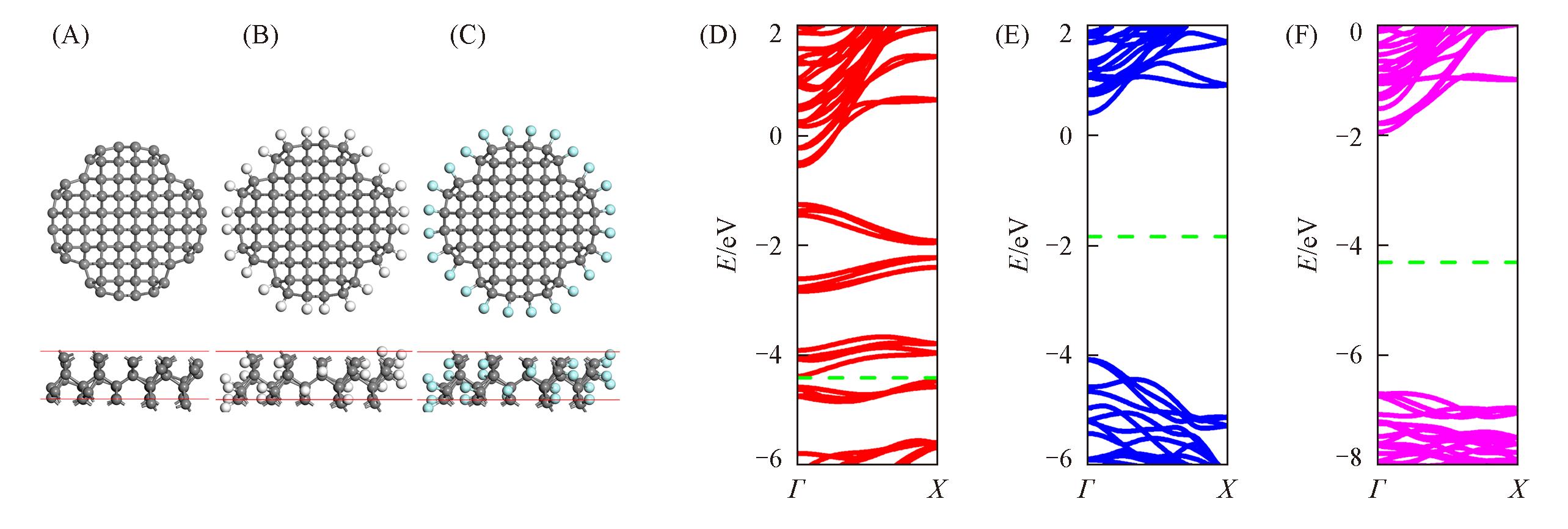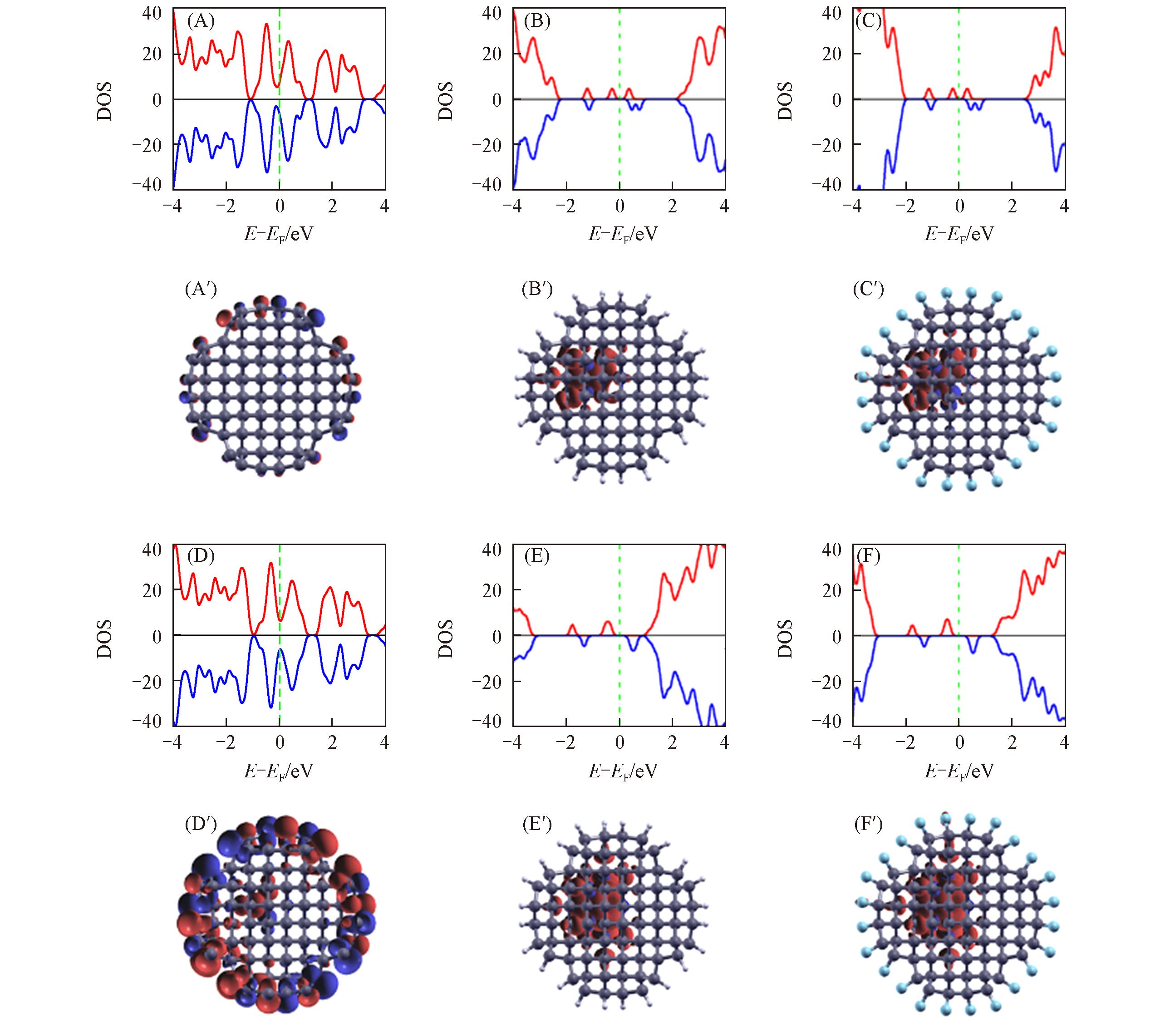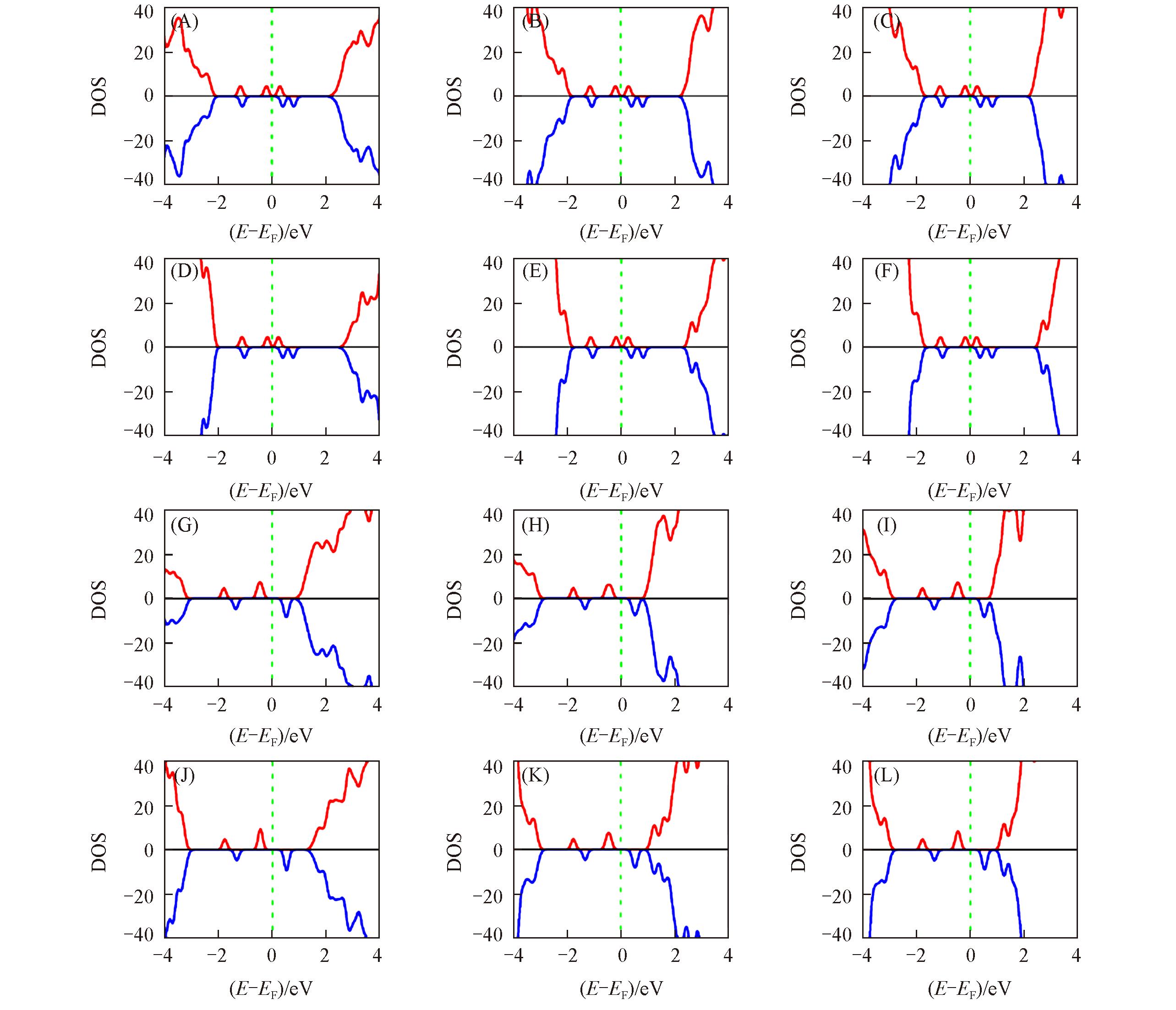

Chem. J. Chinese Universities ›› 2021, Vol. 42 ›› Issue (7): 2178.doi: 10.7503/cjcu20210135
• Article • Previous Articles Next Articles
HU Wei, LIU Xiaofeng, LI Zhenyu, YANG Jinlong( )
)
Received:2021-03-01
Online:2021-07-10
Published:2021-05-20
Contact:
YANG Jinlong
E-mail:jlyang@ustc.edu.cn
Supported by:CLC Number:
TrendMD:
HU Wei, LIU Xiaofeng, LI Zhenyu, YANG Jinlong. Surface and Size Effects of Nitrogen-vacancy Centers in Diamond Nanowires[J]. Chem. J. Chinese Universities, 2021, 42(7): 2178.

Fig.1 Top and side views of atomic structures of clean C3_3_C(A), hydrogenated C3_3_H(B), fluorinated C3_3_F cylindrical DNs(C), and the corresponding electronic band structures(D―F)The white, blue and gray balls denote hydrogen, fluorine and carbon atoms, respectively. The Fermi level is denoted by green dotted lines. The red solid line represents the repeating unitcell of the nanowire along the z direction.

Fig.2 Total density of states(DOS)(A—F) and spin?density isosurfaces(A′—F′) for NV centers doped in DNs with three different surface modifications(A) NV0 in C3_3_C; (B) NV0 in C3_3_H; (C) NV0 in C3_3_F; (D) NV- in C3_3_C; (E) NV- in C3_3_H; (F) NV- in C3_3_F. The red and blue color lines(or isosurfaces) represent spin-up and spin-down states, respectively. The white, blue and gray balls denote hydrogen, fluorine and carbon atoms, respectively. The Fermi level is set to zero and denoted by green dotted lines.

Fig.3 Total density of states(DOS) for NV centers doped hydrogenated and fluorinated DNs with different diameters(A) NV0 in C4_3_H; (B) NV0 in C4_5_H; (C) NV0 in C6_5_H; (D) NV0 in C4_3_F; (E) NV0 in C4_5_F; (F) NV0 in C6_5_F; (G) NV- in C4_3_H; (H) NV- in C4_5_H; (I) NV- in C6_5_H; (J) NV- in C4_3_F; (K) NV- in C4_5_F; (L) NV- in C6_5_F. The red and blue color lines represent spin-up and spin-down states, respectively. The Fermi level is set to zero and denoted by green dotted lines.

Fig.4 Formation energy(Eform) of two NV centers(NV0 and NV-) doped in hydrogenated(H) and fluorinated (F) DNs(A), and [NV-]/[NV0] ratio in fluorinated(B) and hydrogenated DNs(C) as a function of temperatureFor NV centers doped in bulk diamond, Eform(NV0)=7.58 eV and Eform(NV-)=5.86 eV.
| 1 | Barry J. F., Schloss J. M., Bauch E., Turner M. J., Hart C. A., Pham L. M., Walsworth R. L., Rev. Mod. Phys., 2020, 92, 015004 |
| 2 | Doherty M. W., Manson N. B., Delaney P., Jelezko F., Wrachtrup J., Hollenberg L. C., Phys. Rep., 2013, 528, 1—45 |
| 3 | Schirhagl R., Chang K., Loretz M., Degen C. L., Annu. Rev. Phys. Chem., 2014, 65, 83—105 |
| 4 | Lu H. C., Lo J. I., Peng Y. C., Chou S. L., Cheng B. M., and Chang H. C., ACS Appl. Mater. Interfaces, 2019, 12, 3847—3853 |
| 5 | Hopper D. A., Shulevitz H. J., Bassett L. C., Micromachines, 2018, 9, 1—30 |
| 6 | Wu Y., Jelezko F., Plenio M. B., Weil T., Angew. Chem. Int. Ed., 2016, 55, 6586—6598 |
| 7 | Kuwahata A., Kitaizumi T., Saichi K., Sato T., Igarashi R., Ohshima T., Masuyama Y., Iwasaki T., Hatano M., Jelezko F., Kusakabe M., Yatsui T., Sekino M., Sci. Rep., 2020, 10, 1—9 |
| 8 | Chen H., Bhave S., Fuchs G., Phys. Rev. Appl., 2020, 13, 054068 |
| 9 | Rodiek B., Lopez M., Hofer H., Porrovecchio G., Smid M, Chu X. L., Gotzinger S., Sandoghdar V., Lindner S., Becher C., Kuck S., Optica, 2017, 4, 71—76 |
| 10 | Kennedy T., Charnock F., Colton J., Butler J., Linares R., Doering P., Phys. Status Solidi B, 2002, 233, 416—426 |
| 11 | Childress L., Dutt M. V. G., Taylor J. M., Zibrov A. S., Jelezko F., Wrachtrup J., Hemmer P. R., Lukin M. D., Science, 2006, 314, 281—285 |
| 12 | Dutt M. V. G., Childress L., Jiang L., Togan E., Maze J., Jelezko F., Zibrov A. S., Hemmer P. R., Lukin M. D., Science, 2007, 316, 1312—1316 |
| 13 | Maze J. R., Stanwix P. L., Hodges J. S., Hong S., Taylor J. M., Capallero P., Jiang L., Dutt M. V. G., Dogan E., Zibrov A. S., Yacobi A., Walsworth R. L., Lukin M. D., Nature, 2008, 455, 644—647 |
| 14 | Balasubramanian G., Chan I. Y., Kolesov R., Al⁃Hmoud M., Tisler J., Shin C., Kim C., Wojcik A., Hemmer P. R., Krueger A., Hanke T., Leitenstorfer A., Bratschitsch R., Jelezko F., Wrachtrup J., Nature, 2008, 455, 648—651 |
| 15 | Bayat K., Sun W. K. C., Gilpin W., Baroughi M. F., Loncar M., CLEO: Applications and Technology, 2014, 1—2 |
| 16 | Childress L., Taylor J. M., Sørensen A. S., Lukin M. D., Phys. Rev. A, 2005, 72, 052330 |
| 17 | Nizovtsev A., Kilin S., Jelezko F., Gaebal T., Popa I., Gruber A., Wrachtrup J., Opt. Spectrosc., 2005, 99, 233—244 |
| 18 | Goss J. P., Jones R., Breuer S. J., Briddon P. R., Öberg S., Phys. Rev. Lett., 1996, 77, 3041 |
| 19 | Hossain F. M., Doherty M. W., Wilson H. F., Hollenberg L. C. L., Phys. Rev. Lett., 2008, 101, 226403 |
| 20 | Gali A., Janzén E., Déak P., Kresse G., Kaxiras E., Phys. Rev. Lett., 2009, 103, 186404 |
| 21 | Doherty M., Dolde F., Fedder H., Jelezko F., Wrachtrup J., Manson N., Hollenberg L., Phys. Rev. B, 2012, 85, 205203 |
| 22 | Manson N. B., Harrison J. P., Diamond Relat. Mater., 2005, 14, 1705—1710 |
| 23 | Solà⁃Garcia M., Meuret S., Coenen T., and Polman A., ACS Photonics, 2019, 7, 232—240 |
| 24 | Tisler J. , Balasubramanian G., Naydenov B., Kolesov R., Grotz B., Reuter R., Boudou J. P., Curmi P. A., Sennour M., Thorel A., Borsch M., Aulenbacher K., Erdmann R., Hemmer P. R., Jelezko F., Wrachtrup J., ACS Nano, 2009, 3, 1959—1965 |
| 25 | Santori C., Barclay P. E., Fu K. M. C., Beausoleil R. G., Phys. Rev. B, 2009, 79, 125313 |
| 26 | Rondin L., Dantelle G., Slablab A., Grosshans F., Treussart F., Bergonzo P., Perruchas S., Gacoin T., Chaigneau M., Chang H. C., Jacques V., Roch J. F., Phys. Rev. B, 2010, 82, 115449 |
| 27 | Bradac C., Gaebel T., Naidoo N., Rabeau J. R, Barnard A. S., Nano Lett., 2009, 9, 3555—3564 |
| 28 | Fu K. M. C., Santori C., Barclay P. E., Beausoleil R. G., Appl. Phys. Lett.,2010, 96, 121907 |
| 29 | Hauf M., Grotz B., Naydenov B., Dankerl M., Pezzagna S., Meijer J., Jelezko F., Wrachtrup J., Stutzmann M., Reinhard F., Garrido J. A., Phys. Rev. B,2011, 83, 081304 |
| 30 | Petráková V., Nesládek M., Taylor A., Fendrych F., Cígler P., Ledvina M., Vacík J., Štursa J., Kučka J., Phys. Status Solidi A, 2011, 208, 2051—2056 |
| 31 | Petráková V., Taylor A., Kratochvílová I., Fendrych F., Vacík J., Kučka J., Štursa J., Cígler P., Ledvina M., Fišerová A., Kneppo P., Nesládek M., Adv. Funct. Mater., 2011, 22, 812—818 |
| 32 | Plakhotnik T., Aman H., Diam. Relat. Mater., 2018, 82, 87—95 |
| 33 | Hu W., Li Z. Y., Yang J., Hou J. G., J. Chem. Phys., 2013, 138, 034702 |
| 34 | Hu W., Li Z. Y., Yang, J., Comput. Theoret. Chem.,2013, 1021, 49—53 |
| 35 | Yu Y., Wu L., Zhi J., Angew. Chem. Int. Ed.,2014, 53, 14326—14351 |
| 36 | Shenderova O., Brenner D., Ruoff R. S., Nano Lett.,2003, 3, 805—809 |
| 37 | Barnard A. S., Russo S. P., Snook I. K., Nano Lett., 2003, 3, 1323—1328 |
| 38 | Barnard A. S., Russo S. P., Snook I. K., Phys. Rev. B, 2003, 68, 235407 |
| 39 | Barnard A. S., Rev. Adv. Mater. Sci.,2004, 6, 94—119 |
| 40 | Yonezu Y., Wakui K., Furusawa K., Takeoka M., Semba K., Aoki T., Sci. Rep., 2017, 7, 1—9 |
| 41 | Babinec T. M., Hausmann B. J., Khan M., Zhang Y., Maze J. R., Hemmer P. R., Loňcar M., Nature Nanotech., 2010, 5, 195—199 |
| 42 | Hausmann B. J., Khan M., Zhang Y., Babinec T. M., Martinick K., McCutcheon M., Hemmer P. R., Loňcar M., Diam. Relat. Mater., 2010, 19, 621—629 |
| 43 | Huck A., Kumar S., Shakoor A., Andersen U. L., Phys. Rev. Lett., 2011, 106, 096801 |
| 44 | Ordejón P., Artacho E., Soler J. M., Phys. Rev. B, 1996, 53, R10441 |
| 45 | Perdew J. P., Zunger A., Phys. Rev. B, 1981, 23, 5048 |
| 46 | Gali A., Fyta M., Kaxiras A., Phys. Rev. B, 2008, 77, 155206 |
| 47 | Gali A., Phys. Rev. B, 2009, 79, 235210 |
| 48 | Gali A., Simon T., Lowther J. E., N. J. Phys., 2011, 13, 025016 |
| 49 | Perdew J. P., Burke K., Ernzerhof M., Phys. Rev. Lett.,1996, 77, 3865 |
| 50 | Junquera J,, Paz Ó., Sánchez⁃Portal D., Artacho E., Phys. Rev. B, 2001, 64, 235111 |
| 51 | Press W. H., Flannery B. P., Teukolsky S. A., Vetterling W. T., New Numerical Recipes, Cambridge University Press, New York, 1986 |
| 52 | Van de Walle C. G., Neugebauer J., J. App. Phys., 2004, 95, 3851—3879 |
| 53 | Castleton C. W. M., Höglund A., Mirbt S., Phys. Rev. B, 2006, 73, 035215 |
| 54 | Weber J. R., Koehl W. F., Varley J. B., Janotti A., Buckley B. B., van de Walle C. G., Awschalom D. D., Proc. Natl. Acad. Sci. USA, 2010, 107, 8513—8518 |
| 55 | Benecha E. M., Lombardi E. B., Phys. Rev. B, 2011, 84, 235201 |
| 56 | Makov G., Payne M., Phys. Rev. B, 1995, 51, 4014 |
| 57 | Bader R., Atoms in Molecules, A Quantum Theory, Oxford University Press, Oxford, 1990, 22 |
| 58 | Sque S. J., Jones R., Briddon P. R., Phys. Rev. B, 2006, 73, 085313 |
| 59 | Cui J. B., Ristein J., Ley L., Phys. Rev. Lett., 1998, 81, 429 |
| [1] | HE Hongrui, XIA Wensheng, ZHANG Qinghong, WAN Huilin. Density-functional Theoretical Study on the Interaction of Indium Oxyhydroxide Clusters with Carbon Dioxide and Methane [J]. Chem. J. Chinese Universities, 2022, 43(8): 20220196. |
| [2] | WONG Honho, LU Qiuyang, SUN Mingzi, HUANG Bolong. Rational Design of Graphdiyne-based Atomic Electrocatalysts: DFT and Self-validated Machine Learning [J]. Chem. J. Chinese Universities, 2022, 43(5): 20220042. |
| [3] | LIU Yang, LI Wangchang, ZHANG Zhuxia, WANG Fang, YANG Wenjing, GUO Zhen, CUI Peng. Theoretical Exploration of Noncovalent Interactions Between Sc3C2@C80 and [12]Cycloparaphenylene Nanoring [J]. Chem. J. Chinese Universities, 2022, 43(11): 20220457. |
| [4] | ZHOU Chengsi, ZHAO Yuanjin, HAN Meichen, YANG Xia, LIU Chenguang, HE Aihua. Regulation of Silanes as External Electron Donors on Propylene/butene Sequential Polymerization [J]. Chem. J. Chinese Universities, 2022, 43(10): 20220290. |
| [5] | CHENG Yuanyuan, XI Biying. Theoretical Study on the Fragmentation Mechanism of CH3SSCH3 Radical Cation Initiated by OH Radical [J]. Chem. J. Chinese Universities, 2022, 43(10): 20220271. |
| [6] | WANG Yuanyue, AN Suosuo, ZHENG Xuming, ZHAO Yanying. Spectroscopic and Theoretical Studies on 5-Mercapto-1,3,4-thiadiazole-2-thione Microsolvation Clusters [J]. Chem. J. Chinese Universities, 2022, 43(10): 20220354. |
| [7] | ZHONG Shengguang, XIA Wensheng, ZHANG Qinghong, WAN Huilin. Theoretical Study on Direct Conversion of CH4 and CO2 into Acetic Acid over MCu2Ox(M = Cu2+, Ce4+, Zr4+) Clusters [J]. Chem. J. Chinese Universities, 2021, 42(9): 2878. |
| [8] | MA Lijuan, GAO Shengqi, RONG Yifei, JIA Jianfeng, WU Haishun. Theoretical Investigation of Hydrogen Storage Properties of Sc, Ti, V-decorated and B/N-doped Monovacancy Graphene [J]. Chem. J. Chinese Universities, 2021, 42(9): 2842. |
| [9] | HUANG Luoyi, WENG Yueyue, HUANG Xuhui, WANG Chaojie. Theoretical Study on the Structures and Properties of Flavonoids in Plantain [J]. Chem. J. Chinese Universities, 2021, 42(9): 2752. |
| [10] | WANG Jian, ZHANG Hongxing. Theoretical Study on the Structural-photophysical Relationships of Tetra-Pt Phosphorescent Emitters [J]. Chem. J. Chinese Universities, 2021, 42(7): 2245. |
| [11] | YANG Yiying, ZHU Rongxiu, ZHANG Dongju, LIU Chengbu. Theoretical Study on Gold-catalyzed Cyclization of Alkynyl Benzodioxin to 8-Hydroxy-isocoumarin [J]. Chem. J. Chinese Universities, 2021, 42(7): 2299. |
| [12] | LIU Yang, LI Qingbo, SUN Jie, ZHAO Xian. Direct Synthesis of Graphene on AlN Substrates via Ga Remote Catalyzation [J]. Chem. J. Chinese Universities, 2021, 42(7): 2271. |
| [13] | YING Fuming, JI Chenru, SU Peifeng, WU Wei. λ-DFCAS: A Hybrid Density Functional Complete Active Space Self Consistent Field Method [J]. Chem. J. Chinese Universities, 2021, 42(7): 2218. |
| [14] | ZHENG Ruoxin, ZHANG Igor Ying, XU Xin. Development and Benchmark of Lower Scaling Doubly Hybrid Density Functional XYG3 [J]. Chem. J. Chinese Universities, 2021, 42(7): 2210. |
| [15] | LIU Changhui, LIANG Guojun, LI Yanlu, CHENG Xiufeng, ZHAO Xian. Density Functional Theory Study of NH3 Adsorption on Boron Nanotubes [J]. Chem. J. Chinese Universities, 2021, 42(7): 2263. |
| Viewed | ||||||
|
Full text |
|
|||||
|
Abstract |
|
|||||